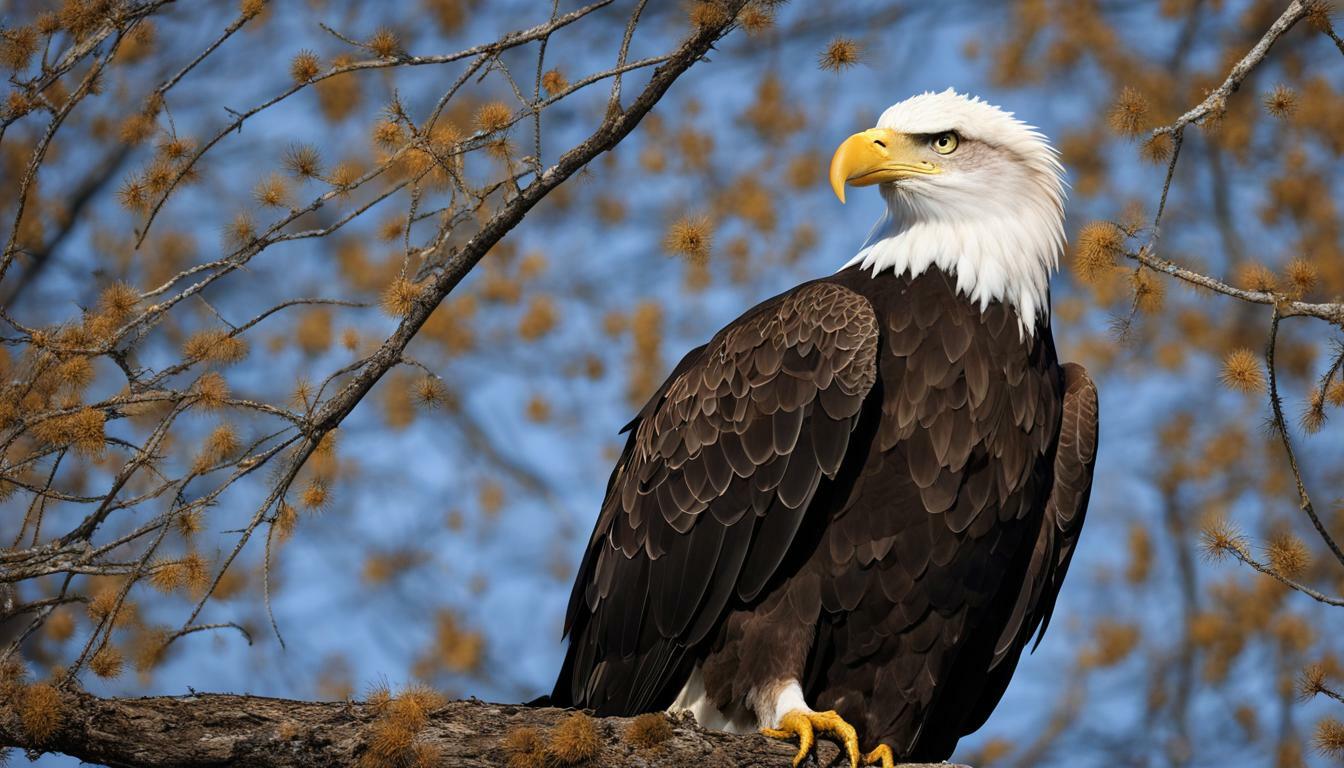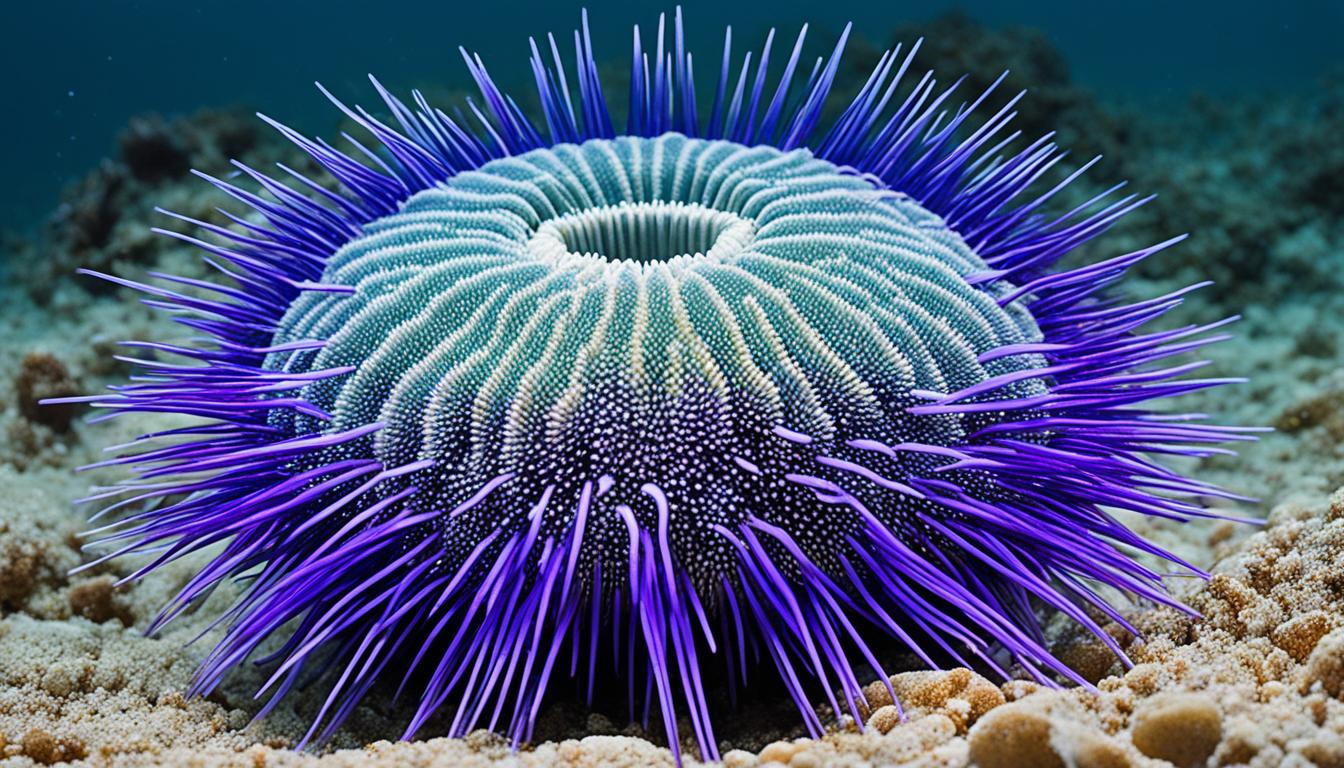If you’ve ever wondered about the sleeping habits of bald eagles, you’re not alone. These majestic birds of prey have long fascinated people with their impressive size and distinctive appearance. And while they are primarily known for their hunting prowess, bald eagles also require sleep to maintain their health and well-being.
So, do bald eagles sleep at night? The answer is yes, but there’s more to it than that. In this article, we’ll explore the fascinating world of bald eagle sleep patterns, including where they sleep, how they sleep, and why it’s so important.
Key Takeaways:
- Bald eagles do sleep at night, but also during the day.
- Eagles exhibit various sleeping positions, including standing up.
- Human activities may disrupt the sleep patterns of bald eagles.
Understanding Bald Eagle Behavior
As majestic symbols of freedom and strength, bald eagles are fascinating creatures to observe in the wild. To better understand these magnificent birds, it’s important to study their behavior patterns, including their sleeping habits.
The Diurnal and Nocturnal Habits of Bald Eagles
Bald eagles are generally diurnal, which means they are active during the day and sleep at night. However, they may also exhibit nocturnal behavior, particularly during the breeding season when they may hunt at night to provide food for their young.
During the day, bald eagles can often be seen soaring high above the trees or perched on a high limb, keeping a watchful eye on their surroundings. They may also be seen fishing for food or scavenging on carrion.
At night, bald eagles will typically fly to a secure location to sleep, such as a tree or tall perch. This helps them avoid predators and stay safe while they rest.
The Social Behavior of Bald Eagles
Bald eagles are also known for their social behavior, particularly during the breeding season. During this time, they may engage in courtship displays, such as soaring together in a synchronized dance or exchanging vocalizations.
Once they have mated, the male and female will work together to build a nest in a high location, such as a tree or cliff. The nest is often large and can be used for many years.
After the eggs are laid, both parents will take turns incubating them and caring for the chicks once they hatch. This includes bringing food to the nest and protecting the young from predators.
The Importance of Studying Bald Eagle Behavior
Studying the behavior of bald eagles is important for understanding their role in the ecosystem and how they interact with other species. It also helps us better appreciate these amazing birds and the important role they play in our natural world.
The Sleep Patterns of Bald Eagles
Have you ever wondered how long and how often bald eagles sleep? You might be surprised to learn that, like humans, bald eagles require a significant amount of sleep each day to function properly. While bald eagles are primarily active during the day, they also sleep at night, typically for several hours.
According to research, bald eagles sleep an average of five to twelve hours per day, with longer sleep periods occurring during the breeding season. Bald eagles also tend to take shorter naps throughout the day, often while perched on a branch or other elevated surface.
Interestingly, bald eagles have the ability to sleep while perched on one leg, using a specialized tendon that automatically locks their toes in place. This allows them to rest while conserving energy and maintaining balance, a skill that is especially important while perched on a tree or other unstable surface.
While bald eagles generally sleep at night, they may also take brief naps during the day. However, they are much less likely to sleep during the day than at night, as they need to remain alert and aware of their surroundings to locate prey and defend their territory.
Overall, understanding the sleep patterns of bald eagles is essential for anyone interested in these majestic birds. By learning more about their habits and behaviors, we can better appreciate and protect these magnificent creatures for generations to come.
Where Do Bald Eagles Sleep at Night?
Have you ever wondered where bald eagles choose to sleep at night? Although they typically prefer to sleep in trees, there are a few other options that they may choose depending on the availability of suitable habitat.
| Sleeping Location | Description |
|---|---|
| Trees | One of the most common sleeping locations for bald eagles is in the branches of large trees, often near bodies of water where they can hunt for food. |
| The Ground | Sometimes, bald eagles will sleep on the ground in open spaces. However, this is less common as they may be more vulnerable to predators. |
| Cliffs | In some areas with rocky terrain, bald eagles may choose to sleep on ledges or cliff faces. |
It’s important to note that bald eagles typically use the same sleeping location repeatedly and may even use the same nest for several years. In fact, they often add new sticks and other materials to the nest to reinforce it and make it more comfortable.
Bald Eagle Bedtime Routine
Have you ever wondered what bald eagles do before they settle down for the night? Just like humans, these majestic birds have specific bedtime routines that help them wind down after a long day of hunting and soaring through the skies.
Before they go to sleep, bald eagles typically spend some time preening their feathers and grooming themselves. This helps them to remove any dirt or debris that may have accumulated during the day and keep their feathers in good condition.
Once they’ve finished grooming, bald eagles often perch on a branch or ledge and spend some time scanning their surroundings. This is a crucial time for them to assess the safety of their sleeping spot and keep an eye out for potential threats.
As the sun starts to set, bald eagles will often tuck their heads under their wings and settle in for the night. They may adjust their position a few times before finally falling asleep, but once they’re comfortable, they’re able to sleep soundly through the night.
Overall, bald eagles’ bedtime routines are an important part of their daily lives and help them to stay healthy and rested for the next day’s activities.
Do Bald Eagles Sleep During the Day?
Have you ever wondered if bald eagles sleep during the day? While these majestic birds are known for soaring the skies during the day, their sleeping habits may surprise you. Bald eagles often take short naps during the day, particularly during the hottest hours when thermals are weaker. However, their daytime sleep patterns differ from their nighttime routine.
Bald Eagles: Diurnal and Nocturnal Creatures
Bald eagles are primarily diurnal creatures, which means they are active during the day and hunt for prey while the sun is up. During the day, they may take short naps on branches or perches, but they remain vigilant and aware of their surroundings.
At night, bald eagles will find a secure place to perch and rest for longer periods of time. It’s common for bald eagles to sleep for several hours during the night, but they also remain alert and aware of their surroundings to protect themselves from potential predators.
Adapting to Different Environments
Their ability to adapt to different environments is impressive. For example, bald eagles in Alaska experience 24-hour daylight during the summer months and 24-hour darkness during the winter months. During summer, they may sleep at different times of the day, but during winter, they tend to sleep more during the long nights.
The Takeaway
So, do bald eagles sleep during the day? The answer is yes, but their daytime sleep habits differ from their nighttime routine. Bald eagles are remarkable creatures that can adapt to different environments and remain vigilant even while asleep. Understanding their sleeping patterns is crucial in protecting their habitat and ensuring their survival.
How Do Eagles Sleep?
Have you ever wondered how eagles sleep? Unlike humans, eagles do not have a designated area for sleep. Instead, they sleep wherever they feel safe and comfortable. This could be in a tree, on the ground, or even while perched on a branch.
While eagles can sleep in various positions, they primarily sleep while standing up. This helps them quickly take flight if needed, as well as keep a close eye on their surroundings. However, eagles may also sleep while sitting or lying down, typically with their head tucked under their wings.
Interestingly, eagles have a unique ability to rest only half of their brain while keeping the other half alert. This is called unihemispheric slow-wave sleep and allows eagles to remain aware of their surroundings, even while sleeping.
Overall, eagles have adaptable sleeping habits that allow them to stay alert and ready for any potential dangers.
The Importance of Sleep for Bald Eagles
Just like humans, sleep is crucial for bald eagles’ health and well-being. The amount of sleep they require depends on their age, with younger eagles needing more sleep than adult ones. Bald eagles spend almost half of their day sleeping, and a lack of sleep can have adverse effects on their ability to hunt, fly, and reproduce.
During sleep, eagles consolidate and process information acquired during their waking hours, which is essential for their survival in the wild. Without proper rest, eagles may not be able to process information efficiently, leading to a decreased ability to react to changes in their environment.
Eagles have also been observed experiencing REM sleep, a stage of sleep characterized by rapid eye movements and vivid dreaming. This suggests that eagles may also engage in learning and memory consolidation during sleep, just like humans.
Conserving energy is another reason why sleep is crucial for eagles. As predators, eagles require a lot of energy to fly and hunt, and sleep helps them conserve energy by reducing unnecessary activity.
Overall, understanding the importance of sleep for bald eagles is crucial to their survival and well-being. As humans, it is our responsibility to protect these magnificent birds by ensuring they have a safe and secure habitat where they can rest and sleep undisturbed.
Sleeping Habits in Different Eagle Species
While bald eagles are one of the most well-known eagle species, there are many other types of eagles that inhabit different regions of the world. As such, it is important to note that sleeping habits can vary between different eagle species.
For example, the golden eagle, which inhabits much of the Northern Hemisphere, is primarily diurnal and is rarely active at night, meaning they sleep during the night like most humans. On the other hand, the crested eagle found in South America is largely nocturnal, hunting at night and sleeping during the day.
While some species of eagles have similar sleeping patterns to bald eagles, such as the white-tailed eagle found in Europe and Asia, others have vastly different sleep patterns. This highlights the importance of understanding the habits of specific species, not only for scientific research but also for bird enthusiasts and nature lovers alike.
Human Impact on Bald Eagle Sleep
Unfortunately, human activities can have a negative impact on bald eagles’ sleep patterns. One significant factor is habitat destruction, as eagles rely on specific environments for their nests and sleeping locations.
Additionally, noise pollution can disturb eagles’ sleep, especially if they are attempting to sleep during the day. Human presence and activity can also cause eagles to move their sleeping location, disrupting their natural sleep patterns.
Another potential problem is artificial lighting, which can interfere with eagles’ ability to sleep at night. Bright lights can disrupt their natural circadian rhythm and make it difficult for them to fall asleep or stay asleep. This is particularly relevant for eagles sleeping in urban areas or near human-developed environments.
It is essential to minimize human impact on bald eagle habitats to help support their natural sleep patterns and overall survival.
Conclusion
Now that you know more about the sleep habits of bald eagles, you can appreciate these magnificent birds even more. As diurnal creatures, bald eagles are active during the day and rest during the night. They typically sleep in trees or on the ground, and have a consistent bedtime routine. Bald eagles also need sleep to maintain their health and well-being, just like humans.
It’s important to be aware of the potential impact that human activities can have on bald eagles’ sleep patterns. By being respectful of their habitats and minimizing disruptions, we can help ensure that these majestic birds continue to thrive in the wild.
So the next time you spot a bald eagle soaring through the sky or perched on a tree, you can appreciate the beauty of their sleeping habits and the important role sleep plays in their lives.
FAQ
Q: Do bald eagles sleep at night?
A: Yes, bald eagles do sleep at night. They are diurnal birds, meaning they are active during the day and rest during the night.
Q: What are the sleep patterns of bald eagles?
A: Bald eagles typically sleep for a few hours at a time, with short periods of wakefulness in between. They may take multiple short naps throughout the day and night.
Q: Where do bald eagles sleep at night?
A: Bald eagles often choose tall trees near bodies of water as their nighttime sleeping spots. They may also sleep on the ground or in other suitable perches.
Q: What is the bedtime routine of bald eagles?
A: Before sleep, bald eagles may engage in behaviors such as preening their feathers and making vocalizations. These rituals help them prepare for rest.
Q: Do bald eagles sleep during the day?
A: While bald eagles primarily sleep at night, they may also take short naps during the day. However, their main sleep period is typically during the night.
Q: How do eagles sleep?
A: Eagles sleep by perching on branches or other secure structures. They may sleep while standing up, using one leg to maintain balance, or even while sitting on the ground.
Q: Why is sleep important for bald eagles?
A: Sleep is crucial for bald eagles’ overall health and well-being. It allows them to rest, recharge, and process information, helping to maintain their physical and mental capabilities.
Q: What are the sleeping habits of different eagle species?
A: While this FAQ primarily focuses on bald eagles, other eagle species may have similar sleep patterns. However, there may also be variations depending on the specific species.
Q: How does human impact affect bald eagle sleep?
A: Human activities or environmental factors can disrupt bald eagles’ sleep patterns. Disturbances such as noise pollution or habitat destruction can interfere with their ability to sleep peacefully.










